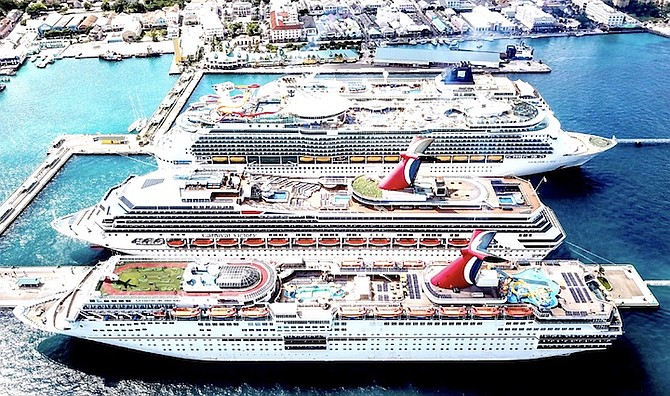• Investors must wait three years to redeem, one to sell
• $25m IPO in ‘overwhelming’ response; to be fully taken
• Adviser predicts up to $10m subscribed for on first day
By NEIL HARTNELL
Tribune Business Editor
nhartnell@tribunemedia.net
Nassau Cruise Port is forecasting that it will start generating profits by 2024 - a timeline that coincides with the end of a three-year “lock-up” for investors in its 49 percent local shareholder.
The Bahamas Investment Fund’s (BIF) investment memorandum, released to potential investors yesterday with the $25m initial public offering’s (IPO) launch, discloses that there are two so-called “lock-up” periods during which persons will not be able to redeem and/or dispose of their shares in the cruise port equity owner.
For one year, until December 31, 2022, investors who buy into the Bahamas Investment Fund’s IPO “will not be able to transfer, sell, pledge, grant any option to purchase or otherwise dispose of” their shares in the pooled investment vehicle.
And, for a three-year period lasting until December 31, 2024, investors “will not be able to redeem any shares in the” Bahamas Investment Fund. The restrictions further affirm comments by Michael Maura, Nassau Cruise Port’s chief executive, that the IPO is “not for someone looking to make a quick buck”.
Anthony Ferguson, president of CFAL, the cruise port’s financial advisers, said the three-year “redemption lock-up’s” end was designed to coincide with when the Bahamas Investment Fund expects to receive its first dividend from Nassau Cruise Port in 2025.
This, in turn, would give the BIF the necessary liquidity to redeem shares from investors who want to exit their investment, while also coinciding with Nassau Cruise Port’s first full year of post-construction operations and projected first year of profitability.
However, once in, no investor will be able to exit for a whole year. And those seeking to “redeem”, rather than sell their BIF shares to another investor, will be unable to get out for three years. Still, Mr Ferguson told Tribune Business that the BIF IPO appeared on course to raise up to $10m, or 40 percent of the total capital sought, within its first day.
“We expect this to be a very successful offering based on the demand we’ve seen so far,” he said. “Overwhelming is perhaps the best way to put it. We expect to have more than one-third at the end of the day, possibly over $10m. We fully expect to be oversubscribed.”
He added that the Bahamas Investment Fund’s website saw its bandwidth doubled twice yesterday to enable it to cope with the level of inquiries and demand from investors, after the site crashed in the morning.
The BIF offering memorandum forecasts that the Nassau Cruise Port, in which it will hold a 49 percent equity ownership stake on behalf of its Bahamian investors, will suffer a $10.1m net loss for the 12 months to year-end 2021 due to a combination of the cruise industry’s COVID shutdown - which only lifted in July - and the ongoing interest and other construction-related costs.
These losses are projected to decline to $2.4m and $4.9m in 2022 and 2023, respectively, before the Prince George Wharf operator makes it into ‘the black’ in 2024 with a $100,000 forecast net profit.
Net income is then projected to rise steadily to $3.4m in 2025, with further increases to $6.9m and $10.7m in 2026 and 2027, respectively. Over that time period, top-line revenues - earned largely from user fees paid by cruise passengers on ships that dock at Nassau Cruise Port, are forecast to rise from $45m in 2024 to $52.9m in 2026 and $57.4m in 2027.
And operating income, or earnings before interest, taxation, depreciation and amortisation (EBITDA) are projected to grow from $27.9m with a 62 percent margin in 2024 to $38.5m and a 67.1 percent margin in 2027.
Mr Maura yesterday said Nassau Cruise Port derives “90 percent-plus of our income” from the $8.50 per head passenger facility fee. He revealed that the fee is “based on the manifest”, meaning that all passengers must pay regardless of whether they disembark the vessel, and that the cruise port has “the discretion” to increase it in line with inflation as measured by the US consumer price index.
With the investment required to transform Prince George Wharf into “a best in class cruise port” and waterfront destination having increased to $303m, as opposed to the initially projected $250m, Mr Maura said the project was driven by the need to enhance a key Bahamian tourism gateway and the industry’s surrounding product.
“A lot of it is on the back of decades of tourist reports and Bahamian comment that downtown has lost its lustre, its magic, and is growing old,” he asserted. “This project is as much about that as anything.”
However, there is no guarantee that the Bahamas Investment Fund will list its shares on the Bahamas International Securities Exchange (BISX), which could be a key requirement for those investors seeking greater transparency, liquidity and price certainty. “The shares are not listed on BISX. In the future, the fund may list the shares on BISX,” the offering memorandum said
Nassau Cruise Port will also pay the offering expenses, estimated at 1.5 percent of total subscriptions. The BIF’s first audited financial statements will be issued for the year ending on March 31, 2023. CFAL is acting as investment manager, placement agent, sponsor and administrator for BIF, while CFAL Securities will be the investment fund’s custodian





Comments
Use the comment form below to begin a discussion about this content.
Sign in to comment
Or login with:
OpenID